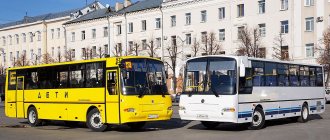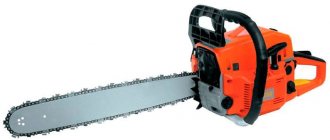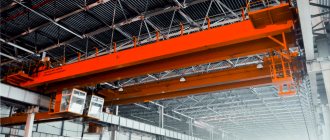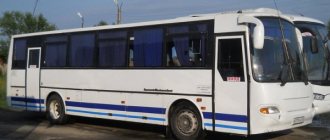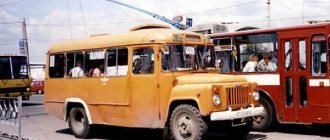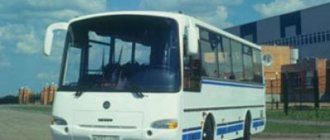In what city are groove buses made?
The production of buses at the plant in Pavlov began in 1952 with the production of the PAZ-651 hood model, which has minor differences from the GZA-651. The year 1958 was marked by the start of production of the new basic model PAZ-652, completely developed by plant employees.
Interesting materials:
How to call a landline phone in Rostov-on-Don? How to call an extension from a landline? How to call from a home phone to Kyiv? How to call Latvia from a home phone? How to call from a home phone to Novosibirsk? How to call from a home phone to Russia? How to call from a landline to a mobile phone in Ukraine? How to call from a mobile to a landline in Odessa? How to call from a mobile phone to a landline phone in Zaporozhye? How to call from Skype to a mobile phone for free?
Bus technical characteristics
The technical characteristics of the KAvZ 685 met the requirements of its time. The first bus models were equipped with four-stroke eight-cylinder carburetor engines ZMZ-53A. The cylinders were arranged in a V-shape. The power unit had a power of 120 horsepower at a rotation speed of 3200 rpm. The torque was 245 N*m at a speed of 2000-2500 rpm. The working volume is 4254 cubic centimeters. The bus consumed 24 liters of fuel per 100 kilometers. The capacity of the fuel tank was 105 liters. The maximum speed was 90 km/h. The vehicle was equipped with a four-speed manual gearbox. It was a slightly modified GAZ-53-12 model, which received synchronizers for third and fourth gears.
The KAvZ 685 used a dry-type single-plate clutch with peripheral spring mechanisms. The switching was carried out using a hydraulic drive. The brake system had two circuits and drum mechanisms acting on all wheels. A hydraulic drive equipped with a vacuum booster was responsible for switching on. The tires used were 8.25R20 tires with a universal tread pattern.
Overall dimensions of the KAVZ 685 bus: length - 6.6 meters, width - 2.55 meters, height - 3.03 meters, wheelbase - 3.7 meters, ground clearance - 265 millimeters, front track - 1.63 meters, rear track - 1.97 meters. The curb weight of the vehicle was 4.08 tons, and the gross weight was 6.545 tons. Axle load distribution: front - 2,225 tons, rear - 4,320 tons. Wheel formula - 4x2. The minimum turning radius was 9 meters.
KAvZ 685 had 21 seats and a total of 28 passengers. There was only one side door for boarding. There was also an emergency exit through the rear emergency door. The salon received a good heating system, which made it possible to warm up the interior well in cold weather. Ventilation was carried out naturally using opening side windows and hatches. For the comfort of passengers, soft seats were installed, trimmed with thick fabric, which was highly resistant to wear and could last several seasons before being replaced. The driver's compartment was not separated from the passenger compartment, which was acceptable according to old safety standards. The driver had his own door for boarding.
The bus had an all-metal bonnet-type body. The presence of a hood significantly simplified access to all components and systems of the engine, which made it easy to carry out service and repairs. Repairing the KAvZ 685 did not cause much trouble. The bus was built on the GAZ-53A chassis, which passed numerous tests and was well prepared for off-road use. A high degree of unification made it possible to obtain the necessary parts without any problems. Many years of experience working with basic elements of the chassis and power unit allowed mechanics to quickly find the cause of the malfunction and promptly fix it.
The driver’s workplace had sufficiently comfortable conditions so that a person would not get too tired during regular flights. The seat was adjustable in terms of distance from the dashboard and the angle of the backrest. The steering mechanism did not have a hydraulic booster, but the steering wheel had a large diameter, which made driving the bus somewhat easier. All controls were at hand and easy to access. Of the control instruments, there was only the most necessary, so as not to dissipate attention to secondary indicators. The rear-view mirrors were large and protruded significantly beyond the dimensions of the vehicle to improve visibility. The windshield was divided into two sectors by a central partition. Each half had one windshield wiper. This design did not interfere with normal control of the road situation.
Overview of main modifications
KAVZ 397653 is a modification of the basic model, designed for transporting schoolchildren to their places of study. It was equipped with a slightly modified ZMZ-513.10 engine with a maximum power of 90 horsepower. The rotation speed increased to 3400 rpm. The engine meets the requirements of EURO-1 environmental standards. The bus received a platform extended to 8.47 meters and a second door for boarding passengers. Special equipment did not allow the vehicle to accelerate to a speed greater than 60 km/h, which was done for the safety of children.
Each seat received its own seat belt and a quick communication button with the driver. The number of seats has increased to 22 units. All traumatic protrusions were removed from the design, and the remaining elements were equipped with soft pads. Fuel consumption of KAVZ 397653 is 23 liters per 100 kilometers. The bus is painted yellow and has the words “school bus” on the sides. The model had an improved braking system, and also added ABS to help the driver in emergency situations. The wheel formula of the vehicle is 4x2.
KAVZ 3976-011 is a gas-cylinder modification of the base model. It is equipped with an Italian system for operating on liquefied gas and two refill cylinders of 90 liters each.
KAVZ 3976-020 is a modification for the northern regions of the country. The model received an insulated interior, a powerful heater and an engine pre-heater to start the power unit in any frost.
Repair and maintenance of KAVZ 3976 do not contain problematic issues. The simple design of all components and assemblies allows you to quickly understand the causes of problems and promptly eliminate them. The bus is unpretentious to the quality of oil and fuel and is well adapted for driving on bad roads. Spare parts for KAVZ 3976 can be easily purchased from official dealers of the manufacturer or on the secondary market.
The price of KAVZ 3976 on the secondary market ranges from 50 to 400 thousand rubles. The value depends on the year of manufacture of the model, its mileage and the date of the last major overhaul. Also, old owners could install any additional devices on the vehicle, which will also affect the increase in cost.
Motor transport - rules, norms, regulations
KAVZ buses.
KAVZ buses of category M3 are produced by the Kurgan Bus Plant.
Category M3 includes vehicles used for transporting passengers, having, in addition to the driver’s seat, more than eight seats, the maximum weight of which exceeds 5 tons (for Kurgan buses, the maximum weight - the weight of a bus with passengers - is within 11 tons).
Vehicles of category M3 belong to one or more of three classes (I, II, III) according to GOST R 41.36 and GOST R 41.107:
Class I. Vehicles whose design provides areas for standing passengers, providing the possibility of passenger exchange (city and suburban buses).
Class II. Vehicles designed for the carriage of primarily seated passengers, which may include the carriage of standing passengers in aisles and/or areas not larger than the space required to accommodate two double seats (coaches).
Class III. Vehicles designed exclusively for the carriage of seated passengers (coaches).
Categories and classes of buses are given in GOST R 52051 - 2003 “Mechanical vehicles and trailers. Classification and definitions".
Operating fuel consumption standards for vehicles, including buses, are given in the order of the Ministry of Transport of Russia dated March 14, 2008 N AM-23-r. Examples of fuel consumption calculations for buses are given in this article.
- Buses KAVZ-4235-41/42 and KAVZ-4235-11/12.
Buses for suburban and intercity transport. A comfortable interior and an optimal number of seats make this bus relevant on routes up to 300 km. A bus with an all-metal closed body supporting a carriage structure with a 4×2 wheel arrangement, with a rear engine. Designed for operation in moderately cold climates at ambient temperatures down to minus 45 ° C, with non-garage storage. KAVZ 4235 is equipped with a Cummins or YaMZ engine of Euro-4 environmental standard and a ZF manual gearbox. The total capacity is 54/52 passengers, including 29/31 seats. Overall dimensions 8380/2500/3085 mm, base 3600 mm.
The KAVZ 4235 - 41/42 bus is equipped with a Cummins ISB4.5 E4 160B engine, the bus models 4235-11, 4235-12 are equipped with a YaMZ - 5346 engine. Engine type, both imported and domestic - diesel, four-stroke, turbocharged and cooled charge air. The gas turbine charging system includes: one turbocharger, a system for supplying exhaust gases from the engine to the turbocharger, as well as a system for supplying charge air from the turbocharger to the engine intake manifold through pipes through an air-to-air charge air cooler. About types of diesel fuel it is written in the article of the same name.
On the KAVZ 4235 - 41/42 bus with a Cummins ISB4.5 E4 160B engine, the engine displacement is 4500 cm3, engine power is 113 kW, compression ratio is 17.3. On the KAVZ-4235-11/12 bus with an engine from the Yaroslavl Motor Plant, its working volume is 4430 cm3, power 124 kW, compression ratio 17.5.
Steering mechanism of buses with power steering. Working brake system: pneumatic, dual-circuit, divided into circuits along the axles, drum brakes on all wheels, ABS. Parking brake system : driven from spring energy accumulators to the brake mechanisms of the rear wheels. Spare : one of the circuits of the service brake system. Ventilation is natural, through hatches in the roof and vents in the side windows. The heating system is liquid, using additional heaters. Tires - 8.25 R20″ or 11/70 R22.5″ or 275/70 R22.5.” The volume of luggage compartments is 1.75 m3.
- Buses KAVZ-4235-43 and KAVZ-4235-13.
Urban modification. Overall dimensions 8380x2500x2995 mm, base 3600 mm. Modern design, comfortable interior, compact, roomy and fits well into dense city traffic. The total capacity is 56 seats, including 25 seats. KAVZ 4235-43 with a Cummins engine, KAVZ 4235-13 with a YaMZ engine - 5346.
- KAVZ buses – 4238.
Extended to 10 meters in comparison with the KAVZ bus - 4235 bus model. Dimensions 1000x2500x2995 (mm). Base 4900 mm. Passenger capacity : for the KAVZ 4238-41 modification - the total number of seats is 44, including 39 seats, for the KAVZ 4238-42 modification the total number of seats is 40, including 35 seats. The bus is equipped with a 6-cylinder Cummins 6 ISBe4 210B engine with a displacement of 6.7 liters. Rated engine power is 145 kW at 2300 crankshaft rpm.
The service brake system is a pneumatic dual-circuit drive with division into circuits along the axes, with ABS, drum brakes on all wheels. Heating system - liquid from the engine cooling system and independent heater, 3 heaters. Steering gear - MAZ-64229, power steering. Ventilation is natural through vents and ventilation hatches in the roof.
- Buses KAVZ-4238-71/72.
This model is a bus with an engine running on compressed natural gas - methane. Environmental class of the vehicle is EURO-5. Produced on the basis of the KAVZ-4238 bus with design changes. The purpose of the bus is commuter/intercity. Overall dimensions (length/width/height), mm - 10000 / 2500 / 2995 (3085 - with air conditioning). Base 4900 mm. Technically permissible maximum weight is 12850 kg.
Total number of seats (including seats): for the 71st modification - 44 (39), for the 72nd modification - 40 (35). The number of fuel cylinders is 5 pcs., the total capacity of the cylinders is 615 liters. The cylinders are located under the floor.
Engine (gas) - Cummins 5.9G 230, maximum engine power - 172 kW at 2800 rpm. The engine location is rear, longitudinal. Transmission /mechanical/ - ZF6S1010BO, or EATON FSO-5206, or DYMOS 09056. Compressed natural gas is written about in this article.
- Bus KAVZ-4238-45.
Bus for transporting children. Manufactured on the basis of the KAVZ-4238 bus with additional installations in accordance with GOST R 51160: speed limiting device, retractable running boards, hand luggage racks, “CHILDREN” inscriptions and signs, etc. Overall dimensions (length/width/height) - 10000 / 2500 / 2995 (3085 - with air conditioning). Base 4900 mm.
Two doors 680 mm wide, total number of seats 34, all seating.
Engine - Cummins 6 ISBe4 210B, 6 cylinders, displacement 6.7 liters, power 145 kW at 2300 rpm. The gearbox is manual, 6-speed.
- Bus KAVZ-4239.
Low-floor, medium-capacity bus. Designed to operate on urban routes as the main passenger transport. Large windows in the driver's cabin provide good visibility. The distinctive features of the model are a spacious and beautiful interior, stylish and bright design. The bus is equipped with a Deutz diesel engine that meets the international environmental standard Euro-3 and an EATON FAW gearbox. Bus dimensions - 10290/2550/3050 mm. Base – 5000 mm. The total capacity is 88 passengers, including 23 seats. Warranty period – 18 months or 100 thousand km. Resource -1 million km.
Floor height above road level, mm - 340 at the front and middle doors.
Number/width of doors, mm - 3 / 1260 - front and middle, 630 - rear.
Engine (diesel) - Deutz BF6M 1013-22E3, 6 cylinders, displacement 7.146 l, maximum power 220 hp. (162 kW). Location: posterior, longitudinal. Gearbox - EATON FAW, 6-speed, manual with manual control.
Types: school, long, elongated and more
KAVZ-3278 cargo-passenger bus with a crane-manipulator installation
KAvZ models are divided into several types:
- by appointment;
- by lenght;
- according to design features and configuration.
Purpose:
- general: urban, suburban, intercity;
- special: shift workers, all-terrain vehicles, school.
Length:
- especially small;
- small;
- average;
- large;
- especially large capacity.
Design and equipment:
- hood;
- carriage;
- rear-engine;
- central motor;
- front engine;
- low-floor;
- high-deck.
Gas, diesel and others
Cars also differ in the type of fuel used:
- models KAvZ-685, -3270 – gasoline;
- models KAvZ-4235, -4238, -4239 – diesel;
- model KAvZ-4270 – liquefied gas – methane.
The KAvZ-4270 bus runs on methane. Photo GAZ
Fuel consumption per 100 km, norm and reality
Fuel consumption depends on a number of factors, ranging from the technical condition of the engine to weather conditions. Therefore, the actual consumption is always greater than that stated in the regulatory documents.
- KAvZ – 685, -3270 (gasoline): norm – 24 l/100 km; actual – 27-30 l/100 km;
- KAvZ – 4235 (diesel fuel): norm – 23.5 l/100 km; actual – 27 l/100 km.
- KAvZ - 4238 and its modifications (diesel fuel): norm - 22-24 l/100 km; actual – 25-27 l/100 km.
- KAvZ – 4239 (diesel fuel): norm – 26 l/100 km; actual – 29 l/100 km.
- KAvZ – 4270 (methane): norm – 47 m3/100 km; actual – 47-49 m3/100 km.
Volume of the tank
Model:
- 685, -3270, -4235 – 105 liters;
- 4238 – 170 liters;
- 4239 – 200 liters;
- 4270 – 6 cylinders (665 liters of methane).
How much does it weigh, kg?
Bus KAvZ-3976. Photo Wikipedia
The weight of the most popular KAvZ models is:
- KAvZ-685: curb weight – 4080 kg; total weight – 6450 kg.
- KAvZ -3976: curb weight – 4450 kg; total weight – 5870 kg.
- KAvZ -4235: curb weight – 11040 kg; total weight – 12000 kg.
- KAvZ -4239: curb weight – 10370 kg; total weight – 16360 kg.
- KAvZ -4270: curb weight – 9740 kg; total weight – 16360 kg.
Dimensions/parameters: height, length, width
- -685: length – 6500 mm; width – 2550 mm; height – 3030 mm.
- -3976: length – 6915 mm; width – 2330 mm; height – 3030 mm.
- -4235: length – 8370 mm; width – 2500 mm; height – 2995 mm.
- -4238: length – 9610 mm; width – 2500 mm; height – 2995 mm.
- -4239: length – 10320 mm; width – 2550 mm; height – 3050.
- -4270: length – 10200 mm; width – 2500 mm; height – 3600 mm.
- KAvZ-685, -3976: tires 8.25 R20.
- KAvZ-4235, -4238, -4239, -4270: tires 275/70 R22.5.
How many seats: 19, 35, 39 and more
- KAvZ-685 is equipped with 21 seats. The total number of passengers is 28 people.
- KAvZ -4235: number of seats – 31, total number of passengers – 54.
- KAvZ -4270 (methane): number of seats – 27, total number of passengers – 87.
- KAvZ -4239: number of seats – 23, total number of passengers – 93.
- KAvZ -4238/41: number of seats – 39, total number of passengers – 39.
- KAvZ -4238/42: number of seats – 35, total number of passengers 48.
Features of individual modifications
The KAvZ 685 bus received several modifications that were intended for use in various regions of the vast country.
KAvZ 685S was designed for use in northern regions, where air temperatures reached -60 degrees Celsius. To retain heat well, the bus received insulated interior trim, double-glazed windows for all windows, as well as additional heaters and an engine pre-heater.
KAvZ 685G - modification for use in mountainous areas. For safe movement along the serpentine road, the bus was equipped with additional electrodynamic brakes and retarders. The cabin also included seat belts for each seat.
KAvZ 685M is a modernized version of the basic model, which was assembled on the GAZ-53-12 chassis. The new model received a ZMZ-53-11 engine, which had a maximum net power of 115 horsepower. With the new power unit, the bus could accelerate to a maximum of 80 km/h.
KAvZ 3270 is an updated version of the basic bus. The vehicle was brought into compliance with new safety and environmental protection standards. It was also assigned a new index in accordance with accepted GOSTs.
The price of KAvZ 685 on the secondary market ranges from 170 to 500 thousand rubles. There are also specimens whose cost exceeds 1 million rubles. The final amount depends on the current condition of the body, engine, interior and chassis. Also, previous owners could equip their vehicles with additional instruments and devices, for which they will ask for additional money.

